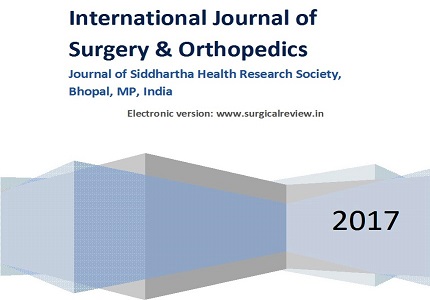Clinical outcomes in metaphyseal locking plate fixation of distal femur and proximal tibia fracture
Abstract
Introduction: Fracture of distal femur and proximal tibial are often difficult to treat and associated with many complications. We aimed to assess the clinical and radiological union time and functional outcome in fractures of distal femur and proximal tibia managed by metaphyseal locking plates and to study the complications associated with it.
Methodology: This prospective study was conducted from June 2014 to October 2016 in the Department of Orthopedics, Dr. DY Patil Medical College, Hospital and Research Centre, Nerul, Navi Mumbai, using a consecutive sample of 50 patients fulfilling our study eligibility. Detailed clinical history of the patients and operative details were noted. All patients were followed up at 3 and 6 months, and were assessed for pain, range of movement (ROM), functional outcomes, union times and complications.
Results: Distal femur fracture were seen in 42% cases (most common type A2) while proximal tibia fractures were seen in 58% cases (most common type II). 28.6% patients showed fracture union by 5 months, 85.74% showed union by 6 months. Complaint of pain at 3 months was given by 22% cases and at 6 months by 6% cases. Delayed, mal and non-union were seen in 12%, 4% and 2% of cases respectively. As per the Oxford Knee Score, excellent outcome was seen in 86% cases while good and fair outcome was seen in 8% and 6% cases respectively.
Conclusion: Metaphyseal locking plates is a superior implant for the fractures around knee with an excellent functional outcome.
Downloads
References
2. Kiran KG, Sharma G, Farooque K, Sharma V, Ratan R, Yadav S, Lakhotia D. Locking Compression Plate in Distal Femoral Intra-Articular Fractures: Our Experience. International scholarly research notices. 2014:372916.
3. Jain R. Prospective Case Study of Outcome of Tibial Plateau Fractures Treated with Locking Condylar Plate. Malaysian orthopaedic journal. 2016;10(3):12.
4. Khatri K, Lakhotia D, Sharma V, GN KK, Sharma G, Farooque K. Functional Evaluation in High Energy (Schatzker Type V and Type VI) Tibial Plateau Fractures Treated by Open Reduction and Internal Fixation. International scholarly research notices. 2014:589538.
5. Singh SK, Kishore N, Singh A, Nag S, Hembram S. A Comparative Study-Plating Of Fracture Around Knee Joint By Mipo V/S Conventional Technique. IOSR Journal of Dental and Medical Sciences. 2015;14(1):37-47.
6. Gupta SV, Dande R. Surgical management of fracture of distal end of femur in adults by minimal invasive percutaneous plate osteosynthesis (MIPPO) with locking condylar plate. International Journal of Orthopaedics. 2015;1(2):07-11.
7. Dickson KF, Munz J. Locked plating: clinical indications. Techniques in Orthopaedics. 2007;22(3):181-5.
8. Tan SL, Balogh ZJ. Indications and limitations of locked plating.Injury. 2009 Jul;40(7):683-91. doi: 10.1016/j.injury.2009.01.003. Epub 2009 May 22. [PubMed]
9. Kanabar P, Kumar V, Owen PJ, Rushton N.Less invasive stabilisation system plating for distal femoral fractures.J Orthop Surg (Hong Kong). 2007 Dec;15(3):299-302.
10. Lee JA, Papadakis SA, Moon C, Zalavras CG. Tibial plateau fractures treated with the less invasive stabilisation system. International orthopaedics. 2007;31(3):415-8.
11. Collinge C, Sanders R, DiPasquale T. Treatment of complex tibial periarticular fractures using percutaneous techniques. Clinical orthopaedics and related research. 2000;375:69-77.



 OAI - Open Archives Initiative
OAI - Open Archives Initiative


















 Therapoid
Therapoid

